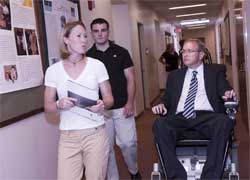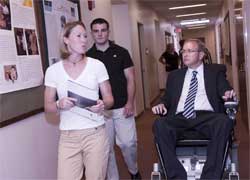 KINGSTON, R.I. – September 2, 2011 – Declining Medicare and insurance reimbursements, salaries for faculty members, and the blizzard of paperwork burying practitioners were among the issues presented by physical therapy and nursing faculty and professionals to Congressman Jim Langevin last week.
KINGSTON, R.I. – September 2, 2011 – Declining Medicare and insurance reimbursements, salaries for faculty members, and the blizzard of paperwork burying practitioners were among the issues presented by physical therapy and nursing faculty and professionals to Congressman Jim Langevin last week.
Langevin met with many of Rhode Island’s nursing and physical therapy leaders at the University of Rhode Island as part of a full day of talks around the state on the issue of health care. During the physical therapy roundtable, he met with URI’s physical therapy faculty and students, and faculty from the Community College of Rhode Island, New England Institute of Technology and private practitioners.
Wendy Baltzer Fox, a physical therapist at Women and Infants Hospital and president of the Rhode Island chapter of the American Physical Therapy Association, said she was glad students attended the roundtable.
“It’s important that you learn about the challenges in the market,” Fox said.
Beth Marcoux, chair of the Department of Physical Therapy at URI, explained to the congressman that URI, like 98 percent of the universities and colleges, prepares its students at the doctoral level. As of 2015, all programs across the country will have converted to the doctor of physical therapy degree as the entry-level credential for the profession. The professional component of the program is typically three years with an average of 103 credits.
Marcoux said providing clinical experience for URI’s physical therapy students is difficult because Medicare does not reimburse clinics for student treatment even when students are supervised directly.
“Therefore, clinics are not willing to take students for hands on experiences,” she said.
The profession also lacks adequate numbers of doctorally prepared faculty with clinical and research expertise, according to Marcoux.
Still, URI’s program remains in high demand. This year it had 280 qualified applicants for its 3-year professional doctoral degree and only 33 were accepted. The incoming class had an average entering grade point average of 3.6.
“But we barely have enough faculty to accommodate such a number,” Marcoux said. “We were initially designed for 25 students, but we continued to increase our acceptance number because there are so many great applicants. Plus, demand is very high. But we need more space and we are finding it more and more difficult to find clinical placements for our students.”
She said cost is becoming an increasingly difficult barrier to enter the profession. Nationally, the average yearly cost of a public in-state program was $43,133 in 2009-2010, while the average cost for out-of-state students at public schools was $81,067. Doctoral programs at private colleges totaled $86,563 for that same year.
With costs so high for just a single year of education, the average national starting salary for physical therapists of about $61,000 makes it difficult for these young professionals to pay off student loan debt.
To help students financially, the national physical therapy association seeks approval of a bill to address students’ loan repayment issues by including them in the the National Health Service Corps. Langevin is a co-sponsor of the Physical Therapist Loan Repayment Eligibility Act.
Nationally, the profession is also taking steps to expand opportunities for minority students. That’s important, Marcoux said, because 81 percent of students are white, with only 6 percent Asian, 3.8 percent African-American and 4.4 percent Hispanic. About 66 percent are women while about 34 percent are men.
Charlestown physical therapist John Ward, owner and operator of his own physical therapy practice, said vacancy rates are very high in the profession.
“Every practice in South County is looking for physical therapists,” he said.
Ward explained that he runs a practice with two physical therapists and two clerical staff. He said the time all four of them spend on paperwork, particularly for the multitude of insurance companies, is crushing. He also addressed frustration with reimbursements, saying that in the Medicare world, one magnetic resonance imaging (MRI) scan is worth an entire year of physical therapy treatment. That’s just crazy,” he said, suggesting that that’s just too little for physical therapy services.
Langevin said two of the main goals of the health care reform bill, which went into effect last year and will be implemented in stages through 2018, are to improve patient outcomes and lower costs.
“But if patients can’t get (physical therapy) services, there are going to be long term consequences,” the congressman said.
He explained that for physical therapy to have the optimum effect, it usually must start shortly after the injury or accident. A delay of only a few days can mean hospital readmissions, extended recovery times and greater costs for patients, hospitals, other health care agencies, which ultimately are borne by consumers and taxpayers.
Beyond reimbursement and paperwork issues, the profession is being damaged by physician-owned physical therapy clinics and infringement on the professional practice by athletic trainers, muscular therapists, personal trainers and chiropractors, Marcoux and Fox said. A paper by the American Physical Therapy Association says “the profit motive for physicians presents a conflict of interest that can result in a loss of patient choice, diminished quality of care and added inconvenience.”
Fox said that use of “physical therapy” billing codes by those who are not physical therapists clouds utilization and effectiveness analysis. There was agreement that such blurring could result in quality of care issues for patients.
Fox noted that the government wants to improve home health care, but such agencies are facing major shortages of physical therapists.
Marcoux said URI is treating patients with Parkinson’s disease at no cost to the patient because Medicare is reluctant to reimburse physical therapists for treatment of patients with degenerative, neurological illness.
“We are hoping to reduce the number of falls among these patients, and thus improve medical outcomes,” Marcoux said.
Pictured above
URI students Lauren Rashford of Utica, N.Y. And Brandon Byrne of Harrington Park, N.J. give Congressman Jim Langevin a tour during his visit to campus last week. Rashford and Byrne are first-year doctoral student in physical therapy.
URI Department of Communications & Marketing photo by Michael Salerno Photography

